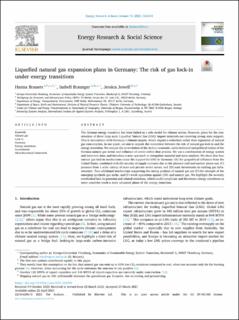| dc.contributor.author | Brauers, Hanna | |
| dc.contributor.author | Braunger, Isabell | |
| dc.contributor.author | Jewell, Jessica | |
| dc.date.accessioned | 2022-03-18T14:35:38Z | |
| dc.date.available | 2022-03-18T14:35:38Z | |
| dc.date.created | 2021-09-20T16:05:07Z | |
| dc.date.issued | 2021 | |
| dc.identifier.issn | 2214-6296 | |
| dc.identifier.uri | https://hdl.handle.net/11250/2986257 | |
| dc.description.abstract | The German energy transition has been hailed as a role model for climate action. However, plans for the construction of three large-scale Liquefied Natural Gas (LNG) import terminals are receiving strong state support. This is inconsistent with Germany’s climate targets, which require a reduction rather than expansion of natural gas consumption. In our paper, we aim to unpack the connection between the risk of natural gas lock-in and the energy transition. We analyse the co-evolution of the techno-economic, socio-technical and political realms of the German natural gas sector and influence of actors within that process. We use a combination of energy system and interview data, and introduce a new approach to triangulate material and actor analysis. We show that four natural gas lock-in mechanisms cause the support for LNG in Germany: (A) the geopolitical influence from the United States, combined with (B) security of supply concerns due to the planned coal and nuclear phase-out, (C) pressure from a wide variety of state and private sector actors, and (D) sunk investments in existing gas infrastructure. Two additional mechanisms supporting the strong position of natural gas are (E) the strength of the emerging synthetic gas niche, and (F) weak opposition against LNG and natural gas. We highlight the severely overlooked lock-in potential and related emissions, which could complicate and decelerate energy transitions as more countries reach a more advanced phase of the energy transition. | en_US |
| dc.language.iso | eng | en_US |
| dc.publisher | Elsevier | en_US |
| dc.rights | Attribution-NonCommercial-NoDerivatives 4.0 Internasjonal | * |
| dc.rights.uri | http://creativecommons.org/licenses/by-nc-nd/4.0/deed.no | * |
| dc.title | Liquefied natural gas expansion plans in Germany: The risk of gas lock-in under energy transitions | en_US |
| dc.type | Journal article | en_US |
| dc.type | Peer reviewed | en_US |
| dc.description.version | publishedVersion | en_US |
| dc.rights.holder | Copyright 2021 the authors | en_US |
| dc.source.articlenumber | 102059 | en_US |
| cristin.ispublished | true | |
| cristin.fulltext | original | |
| cristin.qualitycode | 1 | |
| dc.identifier.doi | 10.1016/j.erss.2021.102059 | |
| dc.identifier.cristin | 1936230 | |
| dc.source.journal | Energy Research & Social Science | en_US |
| dc.relation.project | Norges forskningsråd: 267528 | en_US |
| dc.identifier.citation | Energy Research & Social Science. 2021, 76, 102059. | en_US |
| dc.source.volume | 76 | en_US |

